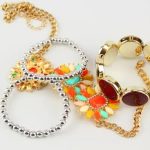The history of costume jewelry can be traced back to ancient civilizations, where people adorned themselves with decorative and ornamental accessories to enhance their appearance. From the glimmering treasures of Ancient Egypt to the intricate designs of the Renaissance period, costume jewelry has played a significant role in fashion and self-expression throughout history.
Costume jewelry, also known as fashion jewelry, is a versatile and affordable alternative to fine jewelry. It encompasses a wide range of materials and styles, allowing individuals to express their personal tastes and stay on-trend without breaking the bank. Over time, costume jewelry has evolved alongside changes in fashion and technology, making it a timeless accessory that continues to captivate enthusiasts worldwide.
In this article, we will explore the origins of costume jewelry, from its early roots in Ancient Egypt to its rise in the 20th century. We will also delve into the significance of notable designers and trends in costume jewelry, its role in pop culture and the fashion industry, as well as the evolution of materials and techniques used in creating these beautiful accessories.
Additionally, we will discuss why costume jewelry maintains its enduring appeal and provide tips for caring for and collecting these unique pieces. Join us on this fascinating journey through the captivating world of costume jewelry.
The Origins of Costume Jewelry
The history of costume jewelry dates back to ancient civilizations, where people adorned themselves with decorative items made from various materials. In Ancient Egypt, both men and women wore jewelry as a symbol of their wealth and status. Jewelry was also believed to offer protection in the afterlife, so it was commonly buried with the deceased. Common materials used for ancient Egyptian jewelry include gold, silver, and semi-precious stones such as lapis lazuli and turquoise.
During the Renaissance period, costume jewelry flourished as advancements in metalwork and gem-cutting allowed for more intricate and elaborate designs. The introduction of faux pearls and colored glass also contributed to the popularity of costume jewelry among the upper class. During this time, jewelry became a status symbol among royals and nobles, with intricate pieces often commissioned to display wealth and power.
As trade expanded during the Renaissance period, costume jewelry began to incorporate materials from different cultures and regions. This led to a diverse array of styles and designs that were influenced by global trade routes. The blending of different cultural influences resulted in stunning pieces that showcased a mix of aesthetics from around the world.
- Ancient Egypt: Gold, silver, semi-precious stones
- Renaissance: Advancements in metalwork, faux pearls, colored glass
- Global Trade: Diverse array of styles influenced by different cultures
The evolution of costume jewelry from ancient times to the Renaissance laid the foundation for the diverse and versatile nature of this form of adornment. The use of different materials, along with cultural influences, set the stage for future innovations in design and craftsmanship that continue to shape costume jewelry today. Understanding these origins helps collectors appreciate the rich history behind their prized pieces and gives designers inspiration for creating new interpretations rooted in tradition.
The Rise of Costume Jewelry in the 20th Century
The 20th century saw a significant rise in the popularity and production of costume jewelry. This era marked a shift in the perception of jewelry as it became more accessible to people from all walks of life. The mass production of costume jewelry allowed for more affordable and diverse options, making it a staple in fashion and self-expression.
During the early 1900s, advancements in technology and manufacturing processes enabled the mass production of costume jewelry. This led to an increase in availability of these accessories, allowing individuals to easily incorporate them into their outfits. Additionally, the changing societal norms and women’s liberation movement during this time contributed to the growing demand for fashion-forward accessories like costume jewelry.
Notable designers such as Coco Chanel and Elsa Schiaparelli played a pivotal role in popularizing costume jewelry in the 20th century. Their innovative designs challenged traditional notions of fine jewelry and paved the way for more creative and experimental pieces. This period also saw trends such as Art Deco and Art Nouveau influencing the design of costume jewelry, resulting in bold and distinctive pieces that reflected the artistic movements of the time.
- The mass production of costume jewelry
- Advancements in technology
- Changing societal norms and women’s liberation movement
- Influence of notable designers such as Coco Chanel
- Trends like Art Deco and Art Nouveau
Notable Designers and Trends in Costume Jewelry
Iconic Designers
Throughout the history of costume jewelry, there have been several iconic designers who have left an indelible mark on the industry. One such designer is Coco Chanel, who popularized costume jewelry in the 1920s with her bold and statement-making pieces. Another influential figure is Miriam Haskell, known for her intricate designs and use of innovative materials. Other notable designers include Kenneth Jay Lane, Elsa Schiaparelli, and Eisenberg, each contributing their unique style to the world of costume jewelry.
Trends in Costume Jewelry
The world of costume jewelry has seen a variety of trends come and go throughout the years. In the 1950s, glamorous Hollywood stars popularized large, sparkling pieces that exuded sophistication and elegance. The 1960s brought about a more playful and colorful aesthetic, with pieces inspired by pop art and psychedelic patterns.
Fast forward to the 1980s, and oversized statement earrings and chunky bracelets dominated the fashion scene. Today, contemporary trends in costume jewelry often reflect a mix of vintage-inspired designs with modern flair, as well as an emphasis on sustainability and ethical production.
Innovations in Design
In addition to iconic designers and trends, costume jewelry has also seen significant innovations in its design over time. From the introduction of new materials like lucite and resin to advancements in manufacturing techniques such as casting and electroforming, designers have constantly pushed boundaries to create fresh and exciting pieces. This spirit of innovation continues to drive the evolution of costume jewelry today, leading to a diverse range of styles that cater to different tastes and preferences.
Overall, the history of costume jewelry has been shaped by talented designers who have continuously reinvented the art form while staying true to its essence. The enduring appeal of costume jewelry lies not only in its beauty but also in its ability to adapt to changing fashion landscapes while retaining its timeless charm.
The Role of Costume Jewelry in Pop Culture
Costume jewelry has played a significant role in pop culture throughout history, making appearances in various forms of media and becoming a symbol of certain eras. From the glamorous Hollywood starlets of the 1950s to the bold and colorful statements of the 1980s, costume jewelry has been showcased in movies, television shows, and fashion magazines, influencing popular trends and styles.
One key example of the impact of costume jewelry on pop culture is seen in Hollywood films and television series. Film icons like Audrey Hepburn and Marilyn Monroe often adorned themselves with eye-catching costume jewelry pieces, setting new trends and inspiring viewers to emulate their style.
In addition, popular TV shows from different decades have also contributed to the prominence of costume jewelry within pop culture. From the elegant pearls and statement brooches of “Downton Abbey” to the bold and chunky designs featured in “Sex and the City,” these influential portrayals have shaped society’s perception of costume jewelry.
Furthermore, musical artists have also utilized costume jewelry as a means of self-expression and pushing boundaries within pop culture. The punk movement of the 1970s embraced unconventional materials, such as safety pins, chains, and plastic beads, as part of their distinctive look.
Additionally, hip-hop artists have popularized oversized gold chains, bamboo earrings, and flashy rings as symbols of success and personal style within their genre. As a result, costume jewelry has become closely associated with specific music genres and subcultures, further solidifying its role in pop culture throughout history.
Costume Jewelry in the Fashion Industry
Costume jewelry has played a significant role in the fashion industry throughout history. From its origins as imitation jewelry to its current status as a popular accessory, costume jewelry has consistently made a statement in the world of fashion. In recent years, there has been a resurgence of interest in vintage costume jewelry, with many designers incorporating vintage pieces into their modern collections.
In the fashion industry, costume jewelry is often used to complement and enhance outfits on the runway and in editorial spreads. Designers frequently incorporate bold and eye-catching costume jewelry pieces into their collections to add an element of glamour and individuality to their designs. Additionally, costume jewelry has become more accessible than ever, with many high-street brands offering affordable yet stylish options for consumers.
Moreover, costume jewelry has also been used to make political and social statements in the fashion world. Designers have often utilized bold and unconventional pieces to challenge traditional notions of beauty and style. The use of costume jewelry for self-expression and making a statement has become increasingly prevalent in contemporary fashion. Overall, costume jewelry remains an integral part of the fashion industry, constantly evolving alongside changing trends and societal norms.
| Role of Costume Jewelry | Fashion Industry |
|---|---|
| Used to complement and enhance outfits on the runway | Designers incorporate bold pieces into their collections |
| Accessible through high-street brands | Affordable yet stylish options for consumers |
| Makes political and social statements | Bold pieces challenge traditional notions of beauty |
The Evolution of Costume Jewelry Materials and Techniques
Costume jewelry has a long and rich history, with its materials and techniques evolving over time to create stunning and unique pieces. From its early origins to the modern day, costume jewelry has continually adapted to incorporate new materials and innovative techniques.
In ancient times, costume jewelry was often made from materials such as glass, beads, and semi-precious stones. These materials were crafted using traditional techniques such as weaving, molding, and carving. During the Renaissance period, costume jewelry became more ornate, with the use of colored gemstones and intricate metalwork becoming more popular.
The 20th century brought about significant changes in the materials used for costume jewelry. With the invention of new synthetic materials such as plastics and acrylics, designers were able to experiment with bold colors and shapes. This led to a wave of creative and avant-garde designs that captured the spirit of the times.
Today, costume jewelry continues to evolve with advancements in technology allowing for the use of innovative materials such as resin, rubber, and 3D printing. Modern techniques also include laser cutting and computer-aided design (CAD), allowing for precise and intricate detailing in costume jewelry pieces. As a result, contemporary costume jewelry offers a wide range of styles and designs that cater to diverse tastes and preferences.
| Evolution of Costume Jewelry Materials | Techniques |
|---|---|
| Ancient times: glass, beads, semi-precious stones | Weaving, molding, carving |
| Renaissance: colored gemstones, intricate metalwork | N/A |
| 20th century: plastics, acrylics | Bold colors & shapes experimentation |
| Modern day: resin, rubber, | Laser cutting & CAD design technology experimentation |
The Enduring Appeal of Costume Jewelry
Versatility
One of the key reasons for the enduring appeal of costume jewelry is its versatility. Unlike fine jewelry, which is often reserved for special occasions, costume jewelry can be worn on a daily basis to complement a wide range of outfits. From casual daytime looks to glamorous evening ensembles, costume jewelry offers endless possibilities for accessorizing.
Affordability
Another factor contributing to the continued popularity of costume jewelry is its affordability. While fine jewelry made with precious metals and gemstones comes with a hefty price tag, costume jewelry provides an accessible way for fashion enthusiasts to experiment with different styles and trends without breaking the bank. This affordability also makes it easier for individuals to build a collection of costume jewelry pieces to suit various occasions and moods.
Making a Statement
Costume jewelry has always been celebrated for its ability to make a bold fashion statement. Whether it’s a chunky statement necklace, oversized earrings, or a stack of bangles, these eye-catching accessories have the power to elevate an outfit and express individual style.
In today’s fashion landscape, where personal expression reigns supreme, costume jewelry continues to thrive as a means for people to showcase their unique tastes and personalities through their accessorizing choices. The history of costume jewelry has paved the way for its enduring appeal in modern fashion culture.
Caring for and Collecting Costume Jewelry
In conclusion, the history of costume jewelry is a testament to its enduring appeal and significance in the fashion world. From its ancient origins to its rise in the 20th century, costume jewelry has continued to captivate enthusiasts and designers alike. Notable designers have made significant contributions to the industry, and costume jewelry has played a prominent role in pop culture as well.
As seen in its evolution of materials and techniques, costume jewelry has adapted and changed with the times while maintaining its allure. Today, it continues to thrive in the fashion scene, with collectors and enthusiasts appreciating its unique charm and style. The tips and tricks for caring for and collecting costume jewelry provided in this article are invaluable for those who wish to preserve these beautiful pieces for years to come.
Overall, it’s clear that the history of costume jewelry is a rich tapestry of artistry, innovation, and cultural significance. As we look back on the origins of this beloved form of adornment, we can appreciate how it has evolved over time while remaining an integral part of fashion history. Whether you’re a seasoned collector or just beginning to appreciate the beauty of costume jewelry, there’s no denying its timeless appeal and enduring legacy.
Frequently Asked Questions
Where Did Costume Jewelry Originate?
Costume jewelry originated in the 18th century in the form of paste or glass jewelry worn by wealthy Europeans. It became popular as an affordable alternative to fine jewelry, and its production expanded during the early 20th century.
How Can You Tell if Costume Jewelry Is Vintage?
Vintage costume jewelry can be identified by its design, materials, and construction. Look for quality craftsmanship, unique designs from specific historical periods, and signs of aging like tarnishing or discoloration.
Is Any Old Costume Jewelry Worth Anything?
While not all old costume jewelry is valuable, some pieces can be worth a significant amount. Factors like designer label, rarity, condition, and demand among collectors all contribute to the value of vintage costume jewelry. It’s best to have pieces appraised by a professional to determine their worth.

Welcome to my jewelry blog! My name is Sarah and I am the owner of this blog.
I love making jewelry and sharing my creations with others.
So whether you’re someone who loves wearing jewelry yourself or simply enjoys learning about it, be sure to check out my blog for insightful posts on everything related to this exciting topic!





